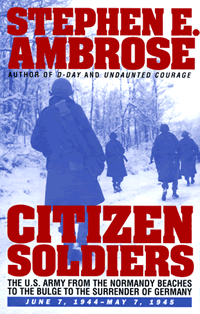|
Decription:
From Publisher's Weekly - Publishers Weekly
The story of the front-line American combatants who took WWII to
the Germans from Normandy to the Elbe River makes, in Ambrose's
expert hands, for an outstanding sequel to his D-Day. These men
are frequently dismissed as winning victories by firepower rather
than acknowledged for their individual fighting power. Using interviews
and other personal accounts by both German and American participants,
Ambrose tells instead the story of enlisted men and junior officers
who not only mastered the battlefield but developed emotional resources
that endured and transcended the shocks of modern combat. Ambrose's
accounts of the fighting in Normandy, the breakout and the bitter
autumn struggles for Aachen and the battles in the Huertgen Forest
and around Metz depict an army depending not on generalship but
on the courage, skill and adaptability of small-unit commanders
and their men. The 1945 offensive into Germany was a triumph of
a citizen army, but the price was high. One infantry company landed
in Normandy on August 8 with 187 men and six officers. By V-E Day,
625 men had served in its ranks. Fifty-one had been killed, 183
wounded and 167 suffered frostbite or trench foot. Nor do statistics
tell the whole story. Ambrose's reconstruction of "a night on the
line" is a brilliant evocation of physical hardship and emotional
isolation that left no foxhole veteran unscarred. It is good to
be reminded of brave men's brave deeds with the eloquence and insight
that the author brings to this splendid, generously illustrated
and moving history.
Table of Contents:
- Table of Contents
- Maps
Introduction and Acknowledgments
Prologue
The Battle for France
Expanding the Beachhead, June 7-30, 1944
Hedgerow Fighting, July 1-24, 1944
Breakout and Encirclement, July 25-August 25, 1944
To the Siegfried Line, August 26-September 30, 1944
The Siegfried Line, October 1944
At the German Border
Metz and the Hurtgen Forest, November 1-December 15, 1944
The Ardennes, December 16-19, 1944
The Ardennes, December 20-23, 1944
The Holiday Season, December 24-31, 1944
Life in ETO
Night on the Line
Replacements and Reinforcements, Fall 1944
The Air War
Medics, Nurses, and Doctors
Jerks, Sad Sacks, Profiteers, and Jim Crow
Prisoners of War
Overrunning Germany Winter War, January 1945
Closing to the Rhine, February 1-March 6, 1945
Crossing the Rhine, March 7-31, 1945
Victory, April 1-May 7, 1945
Epilogue: The GIs and Modern America
Afterword/Notes/Bibliography/Index
- Total pages : Hardcover = 528 pages
- Paperback = 528 pages
 Ed's
Analysis: Ed's
Analysis:
Amazon.com
Stephen E. Ambrose combines history and journalism to describe how
American GIs battled their way to the Rhineland. He focuses on the
combat experiences of ordinary soldiers, as opposed to the generals
who led them, and offers a series of compelling vignettes that read
like an enterprising reporter's dispatches from the front lines.
The book presents just enough contextual material to help readers
understand the big picture, and includes memorable accounts of the
Battle of the Bulge and other events as seen through the weary eyes
of the men who fought in the foxholes. Highly recommended for fans
of Ambrose, as well as all readers interested in understanding the
life of a 1940s army grunt. A sort of sequel to Ambrose's bestselling
1994 book D-Day, Citizen Soldiers is more than capable of standing
on its own.
From Kirkus
A worthy sequel to Ambrose's 1994 D-Day. Bestselling historian Ambrose
(Undaunted Courage) uses firsthand recollections of combat veterans
on both sides to flesh out his well-researched narrative. He picks
up the epic drama by following, almost step by step, various individuals
and outfits among the tens of thousands of young Allied soldiers
who broke away from the deadly beaches of Normandy and swept across
France to the Ardennes, fought the Battle of the Bulge, captured
the famed bridge at Remagen, and crossed the wide Rhine to final
victory in Europe. Ambrose observes that the US broke the Nazi war
machine with massive aerial bombing, artillery, and the great mobility
of attacking tanks and infantry. But, he argues, it was not technology
but the valor and character of the young GIs and their European
counterparts that ultimately proved too much for the vaunted German
forces. While generally approving of Allied military leadership,
Ambrose faults Eisenhower and Bradley as too conservative and believes
the great human and materiel cost of victory could have been reduced
by adopting Patton's more innovative and bolder knockout movements.
He deplores the sending of inadequately trained 18-year-olds as
replacements on the front lines, where they suffered much higher
casualty rates than the foxhole-wise GI veterans. The troops fought
under the worst possible conditions in the Ardennes, during the
worst winter in 40 years; Ambrose describes the long, freezing snowy
nights; the wounds, frostbite, and trench foot; and the fatigue
and the tensions of facing sudden death or maiming. The troops rallied
to drive the enemy back to the Rhine and into Germany, but took
some 80,000 casualties. With remarkable immediacy and clarity, as
though he had trained a telescopic lens on the battlefields, Ambrose
offers a stirring portrayal of the terror and courage experienced
by men at war.

|





 Ed's
Analysis:
Ed's
Analysis: 
